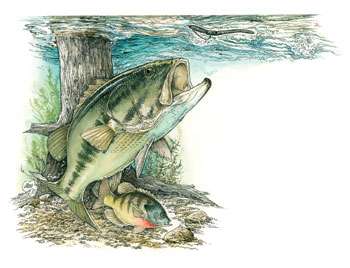
Every bass angler on the planet wants to catch a big one. The problem is, big bass don't act like your average bass. They're different creatures. Steve Kennedy, four-time Bassmaster Classic qualifier, understands this. Over the years he's brought more than his share of giants to the scales.
We asked for his five best techniques. Here's what he had to say:
1.- SKIP THE SPAWN
Obviously, a lot of big bass can be caught during the spawn. I don't work the beds like a lot of other anglers do, however.
Instead, I like to move along the shoreline with my trolling motor on high. When I see a bed I pass it by and then throw back to it with a Kinami Flash. I skip the bait right over the top of the bed. The idea is to startle the bass and trigger a reflex strike.
If I don't provoke a strike with the skip, I'll let the bait settle and lie dead still on the bottom for a while, sometimes as long as 30 or 40 seconds. Occasionally curiosity will get the better of a bedding bass.
My tackle choice for this technique is open-faced spinning equipment and 10-pound-test fluorocarbon line.
2.- SUMMERTIME FROGGIN'
In Northern natural lakes during June, July and August there isn't a better big bass bait anywhere than a frog. I throw mine into shallow, weed-choked areas or pad concentrations and work it as slowly as possible over and through the slop.
If they're really lethargic, try making it quiver in place a time or two. Sometimes adding a rattle will help. The idea is to give them plenty of time to make up their minds. These are big bass. They didn't get that way by accident.
I like the Spro Dean Rojas Bronzeye Frog for most applications. If there's enough open water to walk my frog I usually go with a Reaction Innovations Swamp Donkey. I throw either one with a 7 1/2-foot heavy action Kistler rod and 50-pound-test braided line.
3.- THROW A BUZZBAIT
Immediately after the spawn I like to throw a buzzbait. I start over the old beds and then move out as necessary. (Not all bass spawn at the same time. You'll catch a lot of prespawn fish doing this.)
All of my buzzbaits are homemade by my father, Van, who once fished in the Bassmaster Classic. They're heavy — 3/4 to a full ounce — and are designed with a long shank hook. That keeps the blade from interfering with the hook set. I always use a trailer hook.
Make long casts and cover every inch of water in the area. You never know where the bass are holding, and even if you did, it wouldn't do you much good because these fish move around so much.
I throw my buzzbaits with a 7 1/2-foot Kistler heavy action rod and 50-pound-test braided line. A high-quality, high-speed reel works best. My best bait color is bluegill.
4.- CRANK DEEP STRUCTURE
The trick here is to find the bass first. I suggest you run over the structure with your electronics and then, when you find a school, fish it with a football head jig or a Texas rigged worm to find out what you've got.
After that, work the area with a deep diving crankbait. Jigs and worms will catch numbers; the big ones want a crankbait. My preference in baits is fairly ordinary — Bomber Fat Free Shads, Norman DD 22s and old deep diving Poe's baits will all catch them.
It's important that your lure dig into the bottom and bounce off the structure. If the bass are much deeper than 18 feet, you'll probably be forced to use a football head jig or a big — at least 10 inches long — Texas rigged worm.
Make sure you use a good cranking rod and a heavy reel. Lighter line will give you more depth.
5.- SWIMBAITS ANYTIME
Big, plastic swimbaits will catch lunkers anytime. I really don't have a specific place I throw them. I tie one on when I'm catching bass that are all about the same size. The swimbait will cull the smaller fish and give me a shot at a big one.
Now, understand that when you do this your bite will drop off. Don't expect to catch many fish this way. It's a one- or two-bite technique, suitable only for those anglers who are willing to trade numbers for size.
I like to match the hatch when it comes to color. Mostly I throw Basstrix, Huddleston, Storm and Berkley baits. Something around 6 inches is best for most parts of the country. If you're in giant bass country you might want to upsize to 8 inches. Heavy tackle is a must.




